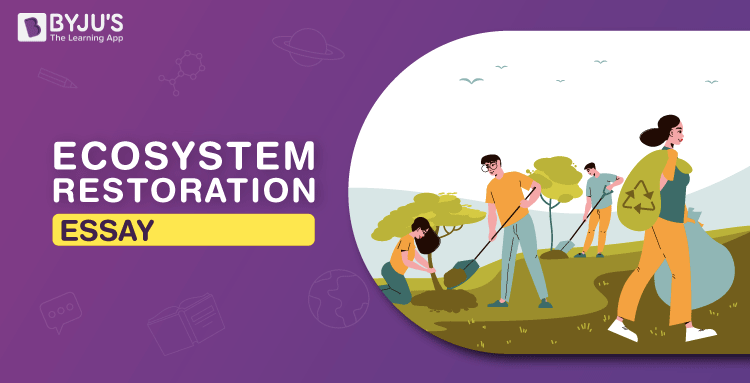Ecosystem restoration, or ecological restoration, is restoring an ecosystem to its natural state cost-effectively and sustainably. In other words, ecosystem restoration refers to restoring ecosystems that have been damaged or disrupted by human activity or natural causes. Ecological restoration aims to create a healthy environment for humans and other organisms. Environmental restoration may involve removing invasive species, reintroducing native species, restoring hydrological balance, or any number of different activities intended to improve an area’s biodiversity and health. There is a lot of pressure on open spaces and natural resources. These projects can range from efforts that simply involve removing invasive species to more complicated ones like bringing back extinct animals. BYJU’S essay on ecosystem restoration explains the significance of the restoration of the environment.
The process of ecosystem restoration is the deliberate and systematic efforts to recreate or replace an ecosystem that has been degraded, damaged, or destroyed. The process is cyclical, where new plants and animals are reintroduced into the area, followed by predators to keep populations in check. The result should be a fully functioning, sustainable ecosystem, much like before it was disrupted. To learn more about the importance of ecosystem restoration, read a short essay on ecosystem restoration.

Importance of Ecosystem Restoration
Ecosystem restoration is essential for many reasons. It helps replenish the number of species in an ecosystem. When an ecosystem declines, there are more disease outbreaks and changes in food webs. Wild animals also struggle to find enough resources. Ecosystems also need restoration because they often fail to recover after catastrophic events. BYJU’S essay writing on ecosystem keeps us informed about the need to restore the environment.
The goal of ecosystem restoration is to improve biodiversity and its health. Efforts are made to repair damages caused by humans and natural disasters. To do this, we need many volunteers willing to dedicate their time to the task. The first thing that an ecosystem restoration team will do is assess the damage and then develop a restoration plan. They would also map out all of the human-made structures in the area and then survey them for any hazardous materials. They would try to keep these structures intact as much as possible because they can often be used in the future for things such as trails or wildlife corridors.
The ecosystems humans have impacted are not as resilient as they once were. Many of the natural habitats that animals live in today have been converted for other land uses or damaged by human activities. The need for these animals is more significant than ever, but restoration of their habitats and the species they rely on can be complex. There are many things that humans can do to make it easier on these animals, such as protecting and restoring critical habitat patches, improving outdoor areas for wildlife, and knowledgeable removal of invasive species.
To conclude, restoring the ecosystem plays a vital role in protecting our mother Earth. By restoring the balance of natural habitats and ecosystems, animals can live in areas that best suit their needs. It is our responsibility as humans to save our nature. For more essays, poems and stories, visit BYJU’S website.
Frequently Asked Questions
Why is it essential to restore the ecosystem?
Ecosystem restoration is significant because it preserves biodiversity and improves the environment. When an ecosystem is restored, it increases the survival rate of endangered animals. It also promotes a healthy environment by reducing environmental stressors like pollution, making room for new species to thrive, and creating more biodiverse habitats.
Why should we restore the ecosystem?
We should restore the ecosystem because it provides many benefits, such as food and water, that make life possible for living beings on the Earth. It also helps make Earth more resilient to extreme weather events like hurricanes, landslides, and forest fires.